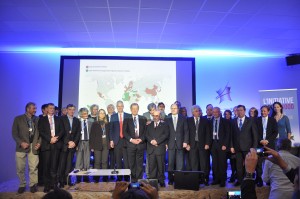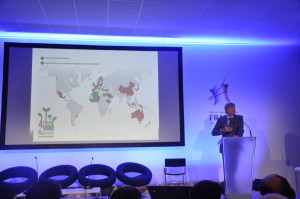By Sara Velander and Jenna Farineau
There are a considerable amount of false solutions out in the world currently. You know – the “green solutions” that multinational corporations promote in their annual sustainability reports. Or the resilience projects that governments boast about during high-level conferences hosted by their town, city, or country. The types of solutions that look so innocent and honorable on the outside but are in reality the antithesis of their underlying goals and morals.
What Jenna and Sara experienced today was one of the extremes of these types of “solutions” to the greatest challenge our population faces today: climate change, a natural and anthropogenic process that is inherently linked to capitalism, terrorism, poverty, and inequity. Today did not just mark the second day of pivotal climate negotiations, but also was the official launch of the 4 per 1000: Soils for Food Security and Climate Initiative. It was a 2.5-hour side event hosted by the French Pavilion and moderated by the General Director for the Economic and Environmental Performance of Enterprises, Ministry for Agriculture, Food Processing Industry and Forestry.
The launch of the initiative started with two 10-minute opening speeches by the CEO of the Global Environment Facility, a financial entity for the initiative, and INRA. The opening speeches were followed by the screening of a four-minute film about soil solutions and a one-hour roundtable discussion with various sponsors and collaborators of the initiative. After the roundtable discussion, key-note speeches were given by agriculture ministers from Uruguay and Germany.
However, the highlight of the event (also the point at which several photographers flooded the room and incessantly snapped away) was the “the declaration of support and signature of the joint declaration of the 4 per 1000 initiative.” The final keynote and conclusion of the session were made by the director-general of the Food and Agriculture Organization and finally the minister for Agriculture of France, who founded and proposed the program.
It wasn’t until after the event when all the speakers posed for a “family photo” that Jenna and Sara noticed how 90% of the speakers on the panel were male, white and from the Global North. The downfalls of this initiative are already clear with this inequitable balance of stakeholders, but will be discussed further In this blog along with a general background of the initiative, a brief overview of the roundtable speakers, conclusion from Le Foll and key take-aways from the event.

For background, the 4 pour 1000 initiative was first announced by the French Minister of Agriculture Stéphane Le Foll back in March of this year at an international conference on Climate Smart Agriculture (CSA) in Montpellier. The main goal for this initiative is to increase the carbon content of soils by 0.4% annually to store all current CO2 emissions, thus ‘catalyzing the reversal of climate change.’ The initiative is comprised of three main objectives: to combat soil degradation, to ensure food security, and to adapt agriculture to climate change.
How it works:
Plant cover captures carbon dioxide, stores it into biomass and releases oxygen through photosynthesis. When the plant dies or decomposes or when compost/manure is added to soil, the carbon is stored within the humus of that soil in hopes to improve soil fertility (by better retaining water and materials). The maximum estimated potential for sequestration is 1.2 GtC (Gigatons of Carbon) per year – which is the equivalent of adding 4 parts of organic carbon to every 1000 parts of organic carbon that is already stored within agricultural soils – hence the name 4 per 1000.
Why 4%?
- A 4% annual growth rate of soil carbon stock would make it possible to stop the present increase of CO2 within the atmosphere.
- The maximum estimated potential for sequestration is 1.2 GtC (Gigatons of Carbon) per year – which is the equivalent of adding 4 parts of organic carbon to every 1000 parts of organic carbon that is already stored within agricultural soils, hence the name 4 pour 1000.
After the promotional film for this initiative was screened, five speakers were called up to be a part of a panel to dive deeper into 4 pour 1000. The speakers were CEO of Consultative Group for International Agricultural Research (CGIAR) Frank Rijsberman, President of Bharatiya Agro Industries Foundation (BAIF) Girish G. Sohani, New Zealand Minister for Climate Change and Trade Tim Groser, Chief Executive Officer of the New Partnership for Africa’s Development (NEPAD), and Farmer and President of L’Association Pour l’Agriculture Durable Tunisia (APAD) Salah Lamouchi. They sat up on stage and were asked a series of set questions from the moderator such as: what is the added value that this initiative brings to international research? How as a policy maker can this 4/1000 initiative help you act for the climate? The panel ended with questions from the audience followed by the signature session for the official launch of this initiative.
Le Foll expressed with great emphasis just how important this initiative is to COP21 and how it sheds new light: “we can finally agree on things and we can capitalize and fight against climate change while fighting at the same time against hunger.” He then went on to say how the solutions can no longer rely on just technology, that it is time for a political response. While he tooted the mighty horn of carbon sequestration, he slipped in the fact that this initiative still needs more funding, as well as a governance system of farmers, NGOs, and the scientific community. So we are still in the beginning stages of a process that, but we must act, because as Le Foll believes “it’s not about surviving and developing your own country, it’s about the world.”
But…
While on face this initiative seems incredibly innovative and good for the planet – who doesn’t want to reverse climate change?! That’s why we’re meeting here in Paris, right? But unfortunately 4 pour 1000 just doesn’t dig deep enough and this is problematic for the hope of a safe future for food security and arable land.
Issue 1: Sequestered soil carbon is not permanent
Issue 2: More carbon storage in the soil can be possibly understood as a means to emit as much if not even more emissions.
Issue 3: This initiative is essentially creating a ‘carbon sink’ and the capacity of that is simply finite.
Issue 4: This initiative quantifies carbon and that results to a carbon market based approach, and market based solutions will not solve market based problems.
Issue 5: The initiative desires to tap into millions of hectares of so-called unused land or land that could be brought back to life through restoration, however this is likely to attract land grabbers and put local communities at risk of securing their land rights.
This initiative simply does not go far enough. There is no explicit connection to the issue of land grabbing, for example. Stéphane Le Foll mentioned today at the launch that he believes public policies on land grabbing are needed to “compliment” the initiative, however (pardon the pun) this is a cop out because he is simply mentioning something and doing nothing to act upon it. There is also no explicit mention of the connection between agroecology. Jenna was fortunate to be chosen as the last person to ask a question, and she asked if the panel speakers could explain the connection between this initiative and agroecology. They were unable to answer the question straightforward, only stating that “food systems are unsustainable and this initiative is good because it will deal with emissions, food security and agroecology” and that “agroecology is at the heart and core of this initiative,” completely avoiding HOW it is actually involved in 4 pour 1000 and to what extent.
This is a band aid solution to a much greater problem that needs stronger emphasis on mitigation and regulation of greenhouse gas emissions, and if we are entering another Green Revolution as Mr. Le Foll mentioned, then we seriously need to step back and assess what we’re about to get ourselves into.


Yes I agree there are a considerable amount of false solutions out in the world currently. Including the “green solutions” that multinational corporations promote in their annual sustainability reports. Or the resilience projects that governments boast about during high-level conferences hosted in their comfort areas I agree the types of solutions that look so innocent and honorable on the outside but are in reality the antithesis of their underlying goals and morals.
However, It is also useful to be somewhat open to the potential and real opportunities of the practical implementation of the 4 for 1000 Initiative: Soil for Food security and Climate.
It is simplistic and prosaic to state that sequestered carbon is not permanent
That needs some more scientific evidence to refute, rather than the bald/banal statement you offered.
However, you were correct to question the veracity of the rhetoric you were exposed to and expected to believe.
I am with you.
I understand that this cannot be achieved as a ‘business as usual’ construct. Radical shifts at a global level requires re-patterning of landscapes at scale to embrace existing and new wildland development , regeneration of indigeneous vegetation patterns and other appropriate multi -tired and multifunctional layers of activities, alternative cropping farming and general enhanced husbandry of land and people in concert with well researched significant and comprehensive land use capability design programmes in place;
and more particularly specifically design for that place and community.
This of course brings the other central and inextricable reality of climate justice and development into focus and the need for serious glocbal and local recognition and action to include (actually include) those vulnerable to the impacts (and politics) of climate change – the poor.
I am sure that these are issues you are all very aware of.
However, all I can offer is the confirmation that there are resources and skills in all sorts of far flung places of the planet who can contribute. Some of us are not that youthful, but we still think and act with innovation. I am in New Zealand.
Please keep in touch, and keep up the good work.